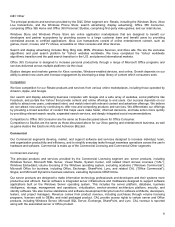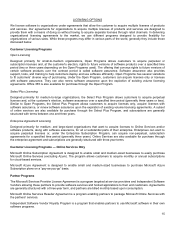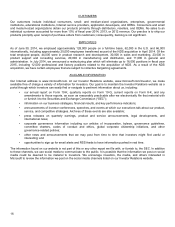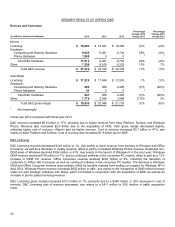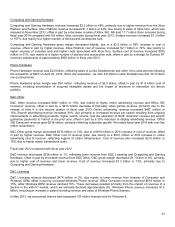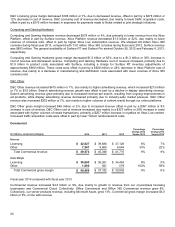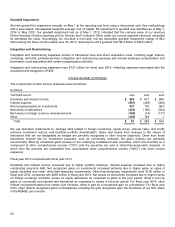Microsoft 2014 Annual Report Download - page 19
Download and view the complete annual report
Please find page 19 of the 2014 Microsoft annual report below. You can navigate through the pages in the report by either clicking on the pages listed below, or by using the keyword search tool below to find specific information within the annual report.18
Cloud operating system
Today, businesses face important opportunities and challenges. Enterprises are asked to deploy technology that
advances business strategy. They decide what solutions will make employees more productive, collaborative, and
satisfied, or connect with customers in new and compelling ways. They work to unlock business insights from a world of
data. They rely on our technology to manage employee corporate identity, and to manage and secure corporate
information accessed and stored across a growing number of devices. To achieve these objectives increasingly
businesses look to leverage the benefits of the cloud. Helping businesses move to the cloud is one of our largest
opportunities, and we believe we work from a position of strength.
The shift to the cloud is driven by three important economies of scale: larger datacenters can deploy computational
resources at significantly lower cost per unit than smaller ones; larger datacenters can coordinate and aggregate diverse
customer, geographic, and application demand patterns improving the utilization of computing, storage, and network
resources; and multi-tenancy lowers application maintenance labor costs for large public clouds. The cloud creates the
opportunity for businesses to focus on innovation while leaving non-differentiating activities to reliable and cost-effective
providers.
With Azure, we are one of very few cloud vendors that run at a scale that meets the needs of businesses of all sizes and
complexities. We believe the combination of Azure and Windows Server makes us the only company with a public,
private, and hybrid cloud platform that can power modern business. We are working to enhance the return on IT
investment by enabling enterprises to combine their existing datacenters and our public cloud into a single cohesive
infrastructure. Businesses can deploy applications in their own datacenter, a partner’s datacenter, or in our datacenters
with common security, management, and administration across all environments, with the flexibility and scale they desire.
Our cloud will also enable richer employee experiences. We enable organizations to securely adopt software-as-a-service
applications (both our own and third-party) and integrate them with their existing security and management infrastructure.
We will continue to innovate with higher level services including identity and directory services, rich data storage and
analytics services, machine learning services, media services, web, and mobile backend services, and developer
productivity services. To foster a rich developer ecosystem, our digital work and life experiences will also be extensible,
enabling customers and partners to further customize and enhance our solutions, achieving even more value. Our
strategy requires continuing investment in datacenters and other infrastructure to support our devices and services, and
will bring continued competition with Google, Amazon, and other well-established and emerging competitors.
Device operating system and hardware
With our Windows device operating system and first-party hardware, we strive to set the standard for productivity
experiences. We aim to deliver the richest and most consistent user experience for digital work and life scenarios on
screens of all sizes – from phones, tablets, and laptops to TVs and large, multi-touch displays. We are investing to make
Windows the most secure, manageable, and capable operating system for the needs of a modern workforce. We are
working to create a broad developer opportunity by enabling universal Windows applications to run across all device
targets. We are developing new input/output methods like speech, pen, and gesture to power more personal computing
experiences.
We work with an ecosystem of partners to deliver a broad spectrum of Windows devices. We also build first-party
hardware to set the standard for productivity experiences and stimulate more demand for the entire Windows ecosystem,
as we do with Surface, and with the acquisition of substantially all Nokia Corporation’s (“Nokia”) Devices and Services
business (“NDS”) on April 25, 2014, phones. As consumer services and hardware advance, we expect they will continue
to better complement one another, connecting the devices people use daily to unique communications, productivity, and
entertainment services from Microsoft and our partners and developers. We anticipate many new mobile device
categories and we anticipate experiences to emerge that span a variety of devices of all screen sizes. We will invest to be
on the forefront of this innovation focusing on dual users and their needs across work and life. With the acquisition of
NDS, we expect our effective tax rate to increase as our business mix changes.



